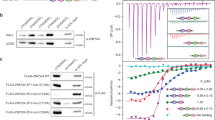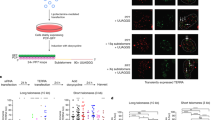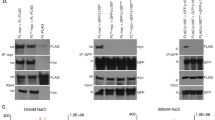Abstract
The cancer-prone and premature aging disease Werner syndrome is due to loss of WRN gene function. Cells lacking WRN demonstrate genomic instability, including telomeric abnormalities and undergo premature senescence, suggesting defects in telomere metabolism. This notion is strongly supported by our finding of physical and functional interactions between WRN and TRF2, a telomeric repeat binding factor essential for proper telomeric structure. TRF2 binds to DNA substrates containing telomeric repeats and facilitates their degradation specifically by WRN exonuclease activity. WRN and TRF2 also interact directly in the absence of DNA. These results suggest that TRF2 recruits WRN for accurate processing of telomeric structures in vivo. Thus, our findings link problems in telomere maintenance to both carcinogenesis and specific features of aging.
This is a preview of subscription content, access via your institution
Access options
Subscribe to this journal
Receive 50 print issues and online access
$259.00 per year
only $5.18 per issue
Buy this article
- Purchase on Springer Link
- Instant access to full article PDF
Prices may be subject to local taxes which are calculated during checkout





Similar content being viewed by others
References
Ancelin K, Brunori M, Bauwens S, Koering C-E, Brun C, Ricoul M, Pommier J-P, Sabatier L and Gilson E . (2002). Mol. Cell. Biol., 22, 3474–3487.
Bianchi A, Smith S, Chong L, Elias P and de Lange T . (1997). EMBO J., 16, 1785–1794.
Bianchi A, Stansel RM, Fairall L, Griffith JD, Rhodes D and de Lange T . (1999). EMBO J., 18, 5735–5744.
Broccoli D, Smogorzewska A, Chong L and de Lange T . (1997). Nat. Genet., 17, 231–235.
Brosh RM, Orren DK, Nehlin JO, Ravn PH, Kenny MK, Machwe A and Bohr VA . (1999). J. Biol. Chem., 274, 18341–18350.
Chakraverty RK and Hickson ID . (1999). Bioessays, 21, 286–294.
Constantinou A, Tarsounas M, Karow JK, Brosh RM, Bohr VA, Hickson ID and West SC . (2000). EMBO Rep., 1, 80–84.
de Lange T . (2002). Oncogene, 21, 532–540.
Fukuchi K, Martin GM and Monnat RJ . (1989). Proc. Natl. Acad. Sci. USA, 86, 5893–5897.
Griffith JD, Comeau L, Rosenfield S, Stansel RM, Bianchi A, Moss H and de Lange T . (1999). Cell, 97, 503–514.
Hemann MT, Strong MA, Hao L-Y and Greider CW . (2001). Cell, 107, 67–77.
Johnson FB, Marciniak RA, McVey M, Stewart SA, Hahn WC and Guarente L . (2001). EMBO J., 20, 905–913.
Kamath-Loeb AS, Johannson E, Burgers PMJ and Loeb LA . (2000). Proc. Natl. Acad. Sci. USA, 97, 4603–4608.
Karlseder J, Smogorzewska A and de Lange T . (2002). Science, 295, 2446–2449.
Kim S-H, Kaminker P and Campisi J . (2002). Oncogene, 21, 503–511.
Lebel M, Spillare EA, Harris CA and Leder P . (1999). J. Biol. Chem., 274, 37795–37799.
Lundblad V . (2002). Oncogene, 21, 522–531.
Machwe A, Xiao L, Theodore S and Orren DK . (2002). J. Biol. Chem., 277, 4492–4504.
Martin GM, Sprague CR and Epstein CJ . (1970). Lab. Invest., 23, 86–92.
Maser RS and DePinho R . (2002). Science, 297, 565–569.
Opresko PL, von Kobbe C, Laine J-P, Harrigan J, Hickson ID and Bohr VA . (2002). J. Biol. Chem., 277, 41110–41119.
Orren DK, Brosh RM, Nehlin JO, Machwe A, Gray MD and Bohr VA . (1999). Nucleic Acids Res., 27, 3557–3566.
Orren DK, Theodore S and Machwe A . (2002). Biochemistry, 41, 13483–13488.
Oshima J . (2000). Bioessays, 22, 894–901.
Poot M, Hoehn H, Runger TM and Martin GM . (1992). Exp. Cell Res., 202, 267–273.
Schulz VP, Zakian VA, Ogburn CE, McKay J, Jarzebowicz AA, Edland SD and Martin GM . (1996). Hum. Genet., 97, 750–754.
Shay JW and Wright WE . (2001). Rad. Res., 155, 188–193.
Smogorzewska A, van Steensel B, Bianchi A, Oelmann S, Schaefer MR, Schnapp G and de Lange T . (2000). Mol. Cell Biol., 20, 1659–1668.
Stansel RM, de Lange T and Griffith JD . (2001). EMBO J., 20, 5532–5540.
Tahara H, Tokutake Y, Maeda S, Kataoka H, Watanabe T, Satoh M, Matsumoto T, Sugawara M, Ide T, Goto M, Furuichi Y and Sugimoto M . (1997). Oncogene, 15, 1911–1920.
Van Steensel B and de Lange T . (1997). Nature, 385, 740–743.
Wyllie FS, Jones CJ, Skinner JW, Haughton MF, Wallis C, Wynford-Thomas D, Faragher RGA and Kipling D . (2000). Nat. Genet., 24, 16–17.
Acknowledgements
We thank Titia de Lange for providing constructs for overproduction of TRF1 and TRF2 and for helpful comments. This work was supported in part by Grant NS-008900 from the Ellison Medical Foundation to DKO.
Author information
Authors and Affiliations
Corresponding author
Rights and permissions
About this article
Cite this article
Machwe, A., Xiao, L. & Orren, D. TRF2 recruits the Werner syndrome (WRN) exonuclease for processing of telomeric DNA. Oncogene 23, 149–156 (2004). https://doi.org/10.1038/sj.onc.1206906
Received:
Revised:
Accepted:
Published:
Issue Date:
DOI: https://doi.org/10.1038/sj.onc.1206906
Keywords
This article is cited by
-
Either Rap1 or Cdc13 can protect telomeric single-stranded 3′ overhangs from degradation in vitro
Scientific Reports (2019)
-
The DNA structure and sequence preferences of WRN underlie its function in telomeric recombination events
Nature Communications (2015)
-
Mechanistic insight into the interaction of BLM helicase with intra-strand G-quadruplex structures
Nature Communications (2014)



